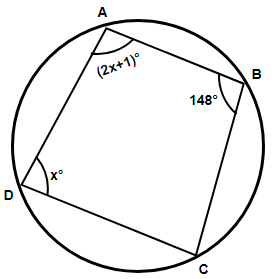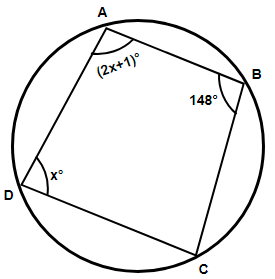
Quadrilateral ABCD is inscribed on the circle. What is the measure of angle A?


Answer
513.9k+ views
Hint: Use the property of a cyclic quadrilateral that ’the sum of opposite angles of cyclic quadrilateral measures 180 degrees’. Consider the angles B and D, take their sum and equate them with 180 degrees to calculate the value of x. Once the value of x is determined, substitute it in the given expression of angle A to get the answer.
Complete step by step solution:
Here we have been provided with a quadrilateral ABCD inscribed in a circle and we are asked to determine the measurement of angle A. Let us use the property of a cyclic quadrilateral.
Now, a quadrilateral is called a cyclic quadrilateral if all of its four vertices lie on the circumference of the circle. In the figure shown below we have all the four vertices A, B, C and D of the quadrilateral lying on the circumference of the circle, so we can say that ABCD is a cyclic quadrilateral.

Now, we know that the sum of opposite angles of a cyclic quadrilateral is 180 degrees, so considering angles B and D we must have mathematically,
\[\Rightarrow \angle B+\angle D={{180}^{\circ }}\]
Substituting the known values from the figure we get,
\[\begin{align}
& \Rightarrow {{148}^{\circ }}+x={{180}^{\circ }} \\
& \Rightarrow x={{180}^{\circ }}-{{148}^{\circ }} \\
& \Rightarrow x={{32}^{\circ }} \\
\end{align}\]
As we can see that we have been provided with the expression of angle A in terms of x as $\angle A=\left( 2x+1 \right)$, so substituting the value of x we get,
$\begin{align}
& \Rightarrow \angle A=\left( 2\left( 32 \right)+1 \right) \\
& \Rightarrow \angle A=\left( 64+1 \right) \\
& \therefore \angle A={{65}^{\circ }} \\
\end{align}$
Hence, the measure of angle A is 65 degrees.
Note: Note that if you are asked to find the measure of angle C at the end then you have two ways to get the answer. First way is to consider angles A and C and use the same property of the cyclic quadrilateral that we have used in the above solution. In the second method you can use the property of a general quadrilateral that the sum of interior angles of a quadrilateral is 360 degrees. Remember that the property we have used to solve the question is proved using the other important property of a circle which states that ‘equal arcs subtend equal angles at the circumference of the circle’.
Complete step by step solution:
Here we have been provided with a quadrilateral ABCD inscribed in a circle and we are asked to determine the measurement of angle A. Let us use the property of a cyclic quadrilateral.
Now, a quadrilateral is called a cyclic quadrilateral if all of its four vertices lie on the circumference of the circle. In the figure shown below we have all the four vertices A, B, C and D of the quadrilateral lying on the circumference of the circle, so we can say that ABCD is a cyclic quadrilateral.

Now, we know that the sum of opposite angles of a cyclic quadrilateral is 180 degrees, so considering angles B and D we must have mathematically,
\[\Rightarrow \angle B+\angle D={{180}^{\circ }}\]
Substituting the known values from the figure we get,
\[\begin{align}
& \Rightarrow {{148}^{\circ }}+x={{180}^{\circ }} \\
& \Rightarrow x={{180}^{\circ }}-{{148}^{\circ }} \\
& \Rightarrow x={{32}^{\circ }} \\
\end{align}\]
As we can see that we have been provided with the expression of angle A in terms of x as $\angle A=\left( 2x+1 \right)$, so substituting the value of x we get,
$\begin{align}
& \Rightarrow \angle A=\left( 2\left( 32 \right)+1 \right) \\
& \Rightarrow \angle A=\left( 64+1 \right) \\
& \therefore \angle A={{65}^{\circ }} \\
\end{align}$
Hence, the measure of angle A is 65 degrees.
Note: Note that if you are asked to find the measure of angle C at the end then you have two ways to get the answer. First way is to consider angles A and C and use the same property of the cyclic quadrilateral that we have used in the above solution. In the second method you can use the property of a general quadrilateral that the sum of interior angles of a quadrilateral is 360 degrees. Remember that the property we have used to solve the question is proved using the other important property of a circle which states that ‘equal arcs subtend equal angles at the circumference of the circle’.
Recently Updated Pages
Master Class 9 Social Science: Engaging Questions & Answers for Success

Master Class 9 Science: Engaging Questions & Answers for Success

Master Class 9 English: Engaging Questions & Answers for Success

Master Class 9 Maths: Engaging Questions & Answers for Success

Master Class 11 Economics: Engaging Questions & Answers for Success

Master Class 11 English: Engaging Questions & Answers for Success

Trending doubts
Which places in India experience sunrise first and class 9 social science CBSE

Fill the blanks with the suitable prepositions 1 The class 9 english CBSE

Write the 6 fundamental rights of India and explain in detail

Difference Between Plant Cell and Animal Cell

What is the Full Form of ISI and RAW

Golden Revolution is related to AFood production BOil class 9 social science CBSE




